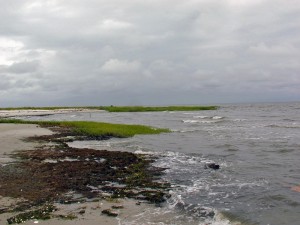Resources Magazine: Private Funding of Public Parks, Assessing the Role of Philanthropy
With private donations making up an increasingly large share of city parks’ revenue, Margaret A. Walls explores the downsides of a heavy dependence on philanthropy.

Source: wallyg / flickr
In 2012, a hedge fund manager made headlines by donating $100 million to the Central Park Conservancy, the largest gift in the park’s history. Though the gesture was initially applauded, it soon faced scrutiny from critics who questioned whether a gift to an already well-funded park should be considered tax-deductible philanthropy, especially when parks in other parts of New York remain chronically underfunded.
This gift highlighted the complicated, ongoing relationship between public parks and their incorporation of private donations. Many communities currently look to philanthropy to fill gaps in park funding—but is this a good idea? The overall increase of philanthropy’s role merits a closer look, as well as whether traditional tax-based methods might be better long-term solutions.
Conservancies and Public–Private Partnerships
Conservancies, “friends of the park” groups, foundations, and other park advocacy organizations have become part of the park landscape in many urban areas. Much of their funding is received through donations, which is mainly used for capital improvement projects, special park activities and programs, and lobbying and advocacy on behalf of the parks. In some unique situations—for example, Central Park—these organizations also are covering park operating costs.
Public–private partnerships that use little or no public funding are also becoming more common in urban environments. In these partnerships, operating revenue comes from a range of outside sources that stretch beyond donations, including user fees, concessions, and restaurant revenue. Money also can be drawn in through property development and in-park fees, as well as from households and businesses located immediately outside of the park’s boundaries. For example, the Bryant Park Corporation—a nonprofit, private management company that operates Bryant Park in Manhattan—created a business improvement district for properties surrounding the park, and those businesses pay the park an annual property assessment. The corporation determines this amount, but it cannot exceed 3 percent of property taxes collected by the city.
Questions about park-based groups were included in a 2009 survey conducted by researchers at RFF, who polled urban park directors about their operations and funding. The 44 directors disclosed that a total of $143 million was generated by donors, conservancies, and foundations in the most recent fiscal year, with only five reporting that they had not received any private contributions. In a separate RFF survey, park organizations were confirmed to be largely funded by donations: 63 percent of the annual revenue of those surveyed was marked as having come from individuals, corporations, and foundations.
Read the rest of this article.
Conservation Return on Investment Analysis: Three Case Studies

Great Bear Rainforest (Source: hmj / flickr)
An increasing number of conservation projects designed to address ecological management, protection, and restoration are being judged based on the investment returns they are able to produce. The costs, benefits, and risks of these projects can all be assessed using conservation return on investment (ROI) analysis, a method to help conservancies prioritize possible programs based on their relative expected yields. In order to assess current ROI capabilities, analysis barriers, and areas of potential improvement, in a new RFF discussion paper, I took a look at three case studies, focusing on large-scale conservation projects in North and South America.
Brazil’s Atlantic Forest region currently operates under a payments for ecosystems services (PES) program, as well as the “Extrema” program, a system which monitors 551,000 acres of area watershed. The area’s severely degraded watershed and high levels of deforestation have motivated conservation projects to preserve the system’s role as a water source for São Paulo. These projects feature several monitoring and modeling innovations which assist in ROI analysis—including baseline vegetation mapping and land cover assessments—though implementation issues for some observation and budgetary plans remain. Many benefits of these programs have also likely gone unmeasured, and could be identified through a social or economic program evaluation.
This Week in the RFF Library Blog
Each week, we review the papers, studies, reports, and briefings posted at the “indispensable” RFF Library Blog, curated by RFF Librarian Chris Clotworthy.
BLM Failed to Inspect Vulnerable Oil Wells, Relied on Outdated Rules and Guidance : GAO
The government has failed to inspect thousands of oil and gas wells it considers potentially high risks for water contamination and other environmental damage, congressional investigators say…Investigators said weak control by the Interior Department’s Bureau of Land Management resulted from policies based on outdated science and from incomplete monitoring data…The audit also said the BLM did not coordinate effectively with state regulators in New Mexico, North Dakota, Oklahoma and Utah… — via NPR
Estimating Local Mortality Burdens Associated with Particulate Air Pollution [UK]
The increase in mortality risk associated with long-term exposure to particulate air pollution is one of the most important, and best-characterised, effects of air pollution on health. This report presents estimates of the size of this effect on mortality in local authority areas in the UK, building upon the attributable fractions reported as an indicator in the public health outcomes framework for England. It discusses the concepts and assumptions underlying these calculations and gives information on how such estimates can be made… — via Public Health England
National Security and the Accelerating Risks of Climate Change
In this follow-up to its landmark study, National Security and the Threat of Climate Change, CNA Corporation’s Military Advisory Board (MAB) re-examines the impact of climate change on U.S. national security in the context of a more informed, but more complex and integrated world… — via CNA Corporation
Resources Magazine: Surveying American Attitudes toward Climate Change
Despite the fact that the nation’s leaders continue to debate the existence of global warming, the American public appears to be nearly united on the topic—and has been for quite some time. According to a survey conducted by RFF, Stanford University, and USA Today, 73 percent of Americans say that the world’s temperature has been going up over the past 100 years (Figure 1). Responses to the same question, asked in previous studies, have been quite consistent over time. For example, in 2010, that number was 74 percent, and in 1997, it was 77 percent.
Another issue under debate is whether humans have been causing Earth to get warmer, or whether warming has been part of a natural cycle. When asked about this in 1997, 81 percent of Americans attributed warming at least partly to human activity. That number was 80 percent in the 2013 survey (Figure 2).
Read the rest of this article.
Adaptation and Liability
A class-action lawsuit (complaint here) by Farmers insurance against Chicago and other Illinois cities has gotten some attention (e.g., here, here, and here) because of its connection with climate change. In simple terms, Farmers (along with other insurers and property owners) suffered a lot of damage as a result of floods in April of last year, most notably in the form of sewer backups into homes and businesses. Farmers claims in the lawsuit that local governments in the area could have done more to prevent this damage, and moreover should have been better prepared since rainfall has increased in the Chicago area in recent decades, ostensibly as a result of climate change.
Commentators have lept to draw broad conclusions about the insurance industry’s reaction to climate and implications for adaptation policy at the local level. For example, Rob Moore at NRDC argues that “[this l]itigation is a symptom of what happens when the response to a recognized problem is insufficient. ” I don’t agree with that view as a general rule - often litigation or at least the threat of litigation is the first and best method of preventing harms - but in this specific case it may be correct. If governments fail to adapt to changing conditions, they should expect litigation as well as political pressure. It seems premature to declare broad conclusions based on a single, newly-filed case, however, and trying to do so risks simply fitting the case into one’s preexisting worldview.
Instead, it’s worth taking a closer look at the case itself first. It strikes me as unusual - admittedly I’m no expert in insurance cases or even civil litigation generally, but I wouldn’t have expected governments to be liable for these kinds of harms. Almost none of the coverage of the case has explained why Farmers thinks they are. I’ll try to do so here. Read More
RFF on the Issues: Managing Coastal Flooding Risks; Ice Sheet Collapse
Managing Coastal Flooding Risks
Alabama port cities, such as Mobile, have the potential to be devastated by “as much as 25 feet of water” from rising seas, according to federal studies. However, local governments can “adopt land use strategies that manage risks effectively,” writes RFF’s Carolyn Kousky. For example: “More flexible property rights, such as rolling easements, have been suggested to allow for private use of the shore until inundation occurs.” RFF’s Margaret Walls suggests that communities might want to consider transfer of development rights to bring about such land use change. She notes: “Importantly, there is no direct cost to the government except the administrative costs of running the program.”
Ice Sheet Collapse
In two recent studies, scientists have reported that the West Antarctic ice sheet has entered an unstoppable “chain reaction” melting phase. One of the study’s authors notes that the “thinning of the ice in recent decades is most likely related to climate change” but that it is difficult to predict how efforts to stop global warming would affect the melt.
At a recent RFF seminar, panelists discussed the challenges of predicting the effects of climate change on ice sheets (video available)—including issues with quantifying the uncertainty associated with the melt. In new research, RFF Chauncey Starr Chair in Risk Analysis Roger Cooke writes that communication about uncertainty must also be improved: “We are now facing decisions that could eventually impact the habitability of the planet as we know it, and we will make those decisions without knowing exactly how current actions affect the future climate . . . . The way forward starts with getting the uncertainty narrative right.”
RFF on the Issues: The US National Climate Assessment
RFF researchers on emissions, sea level, ecosystems, water, adaptation, and poverty
Last week, the US Global Change Research Program released the National Climate Assessment, which concluded “that the evidence of human-induced climate change continues to strengthen and that the impacts are increasing across the country.” In a statement about the assessment, RFF Vice President for Research Molly Macauley said, “The good news is that there are a lot of sensible strategies available. Many are economically beneficial on their own terms and these might be the ones for highest priority to enable this country to prepare effectively for an uncertain future.”
RFF researchers have proposed such strategies for addressing various issues highlighted in the National Climate Assessment.
On reducing fossil fuel emissions:
- Dallas Burtraw says: “The main event is how EPA chooses to regulate the existing electric generating units under the performance standard provision of the [Clean Air Act]. These units are responsible for nearly 40 percent of the country’s carbon dioxide emissions.”
On sea-level rise:
- Carolyn Kousky describes a three-part strategy for managing shoreline retreat, noting: “Property owners accepting the notion that their right to a property is not indefinite in the face of sea-level rise is a necessary, and difficult, first step.”
On protecting ecosystems:
- Jim Boyd calls for ecological hedging strategies: “We can make investments in ecological production to reduce the negative consequences of climate change on ecological wealth.”
On managing water resources:
- Yusuke Kuwayama suggests that the creation of groundwater markets could serve “changing conditions and demands” while preventing large declines in water tables.
On planning for adaptation:
- Daniel Morris, Molly Macauley, Ray Kopp, and Richard Morgenstern write: “The design of national adaptation policy must . . . be resilient against failure in the face of extreme climate-related scenarios and . . . flexible enough that it can meet the needs of local actors across the country in a timely manner and allow for major directional shifts as needed if existing policy proves insufficient.”
On climate change and poverty:
- Joseph Stiglitz notes the connection between environmental policies and inequality in societies, explaining that “small interventions can have very big effects . . . . An example on a national scale that is relevant in many developing countries is the adoption of more efficient cook stoves.”
Should Coastal Communities Consider Transfers of Development Rights?

photo: clarkmaxwell/flickr
My colleague, Carolyn Kousky, recently wrote a post about “managed retreat” from the riskiest areas along our nation’s coastline—areas facing sea-level rise, as well as worsening storms and hurricanes. Her recommended three-part strategy includes limiting development in high-risk areas, adopting policies for “orderly” retreat as inundation occurs, and allowing for retreat after a disaster. All of these involve changes in land use in coastal areas. And these changes in land use will come at a cost. In a world with private property rights, restricting development options through zoning and other regulations reduces property values and can involve costly “takings” legal battles. Property buyouts or purchases of easements, which incentivize property owners to voluntarily move or allow development restrictions to be placed on their lands, can be costly. Where will this money come from?
An option that many local communities should be considering is transfer of development rights (TDRs). TDRs allow development rights on one property to be “lifted” and sold for use on another property. Communities often identify areas they would like to protect from development and designate them as TDR “sending” areas. Landowners in these areas are permitted to sell their development rights and if they do, a permanent easement is usually placed on their land. Buyers of development rights are typically developers who use the rights to build more densely in designated “receiving” areas.
Managing Shoreline Retreat in the United States: A Three-Part Strategy

Source: usfwsnortheast / flickr
Sea-level rise will increasingly threaten coastal communities. Responses to the issue have generally been grouped into three broad categories: protect, accommodate, and retreat. All three of these strategies will be needed and deployed to varying degrees around the United States. Highly developed areas—think New York City—will require some structural protection. Certain facilities that need to locate on the water may be able to accommodate the rising sea, by being elevated, for example. But in some places around the country, retreating from the shore will be preferred on economic or political grounds.
In a new paper in Climatic Change (note: requires subscription), I explore how shoreline retreat could be managed. Retreat could be left to the market, but there are three reasons this may lead to suboptimal outcomes: (1) unilateral investments in shoreline armoring can harm neighboring properties, (2) coastal ecosystems provide public goods that will be underprovided in the market, and (3) private property owners may not optimally invest and divest in coastal areas because they may not have full information, do not bear the full costs of disasters or inundation, and/or may not accurately perceive risks.
In the paper, I propose a three-part strategy for managed retreat: (1) limit development in the highest risk areas, (2) adopt policies to allow for orderly retreat as inundation occurs, and (3) allow for retreat post-disaster. The nuances and challenges of this three-part approach are discussed in detail in the paper. This post gives a brief overview. Read More
Emissions Trading Isn’t Dead, But It’s Not Out of the Hospital Either
The Supreme Court’s recent decision in EPA v. EME Homer City was a big victory for the agency, substantially (though not completely and finally) clearing the way for cap-and-trade programs that had been in legal limbo for the better part of a decade. The DC Circuit decision in the case that SCOTUS overturned prompted me to declare the effective end of emissions trading under this part of the Clean Air Act (Section 110, which deals with “conventional” or “criteria” pollutants like sulfur dioxide and nitrogen oxides). Last week’s decision breathes new life into those flexible programs.
Dan Farber (whose coverage of the case has been extremely useful) writes today that the decision is also cause for optimism about flexibility (read: trading) under other parts of the Act, most importantly Section 111(d), which will soon be used to regulate carbon emissions from existing power plants (and about which we’ve written extensively at RFF). While the recent decision certainly doesn’t hurt (and while I’m broadly optimistic that ESPS can be flexibile), unlike Dan Farber I don’t think it tells us much about how SCOTUS would rule on inevitable challenges to the ESPS.

 Subscribe; to our RSS Feed
Subscribe; to our RSS Feed Tweets by @RFF_org
Tweets by @RFF_org 
Recent Comments